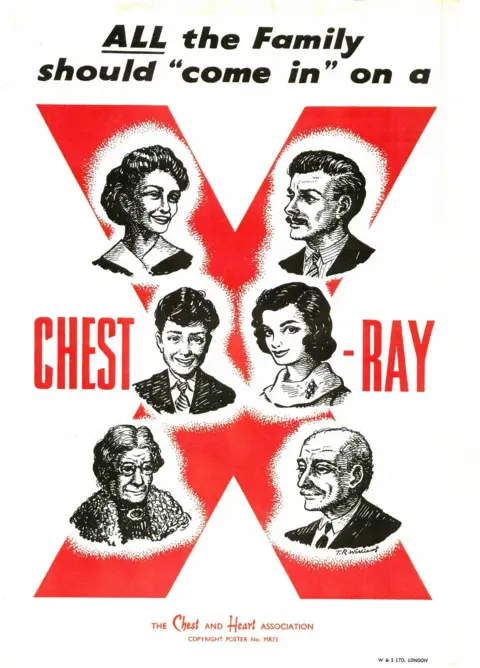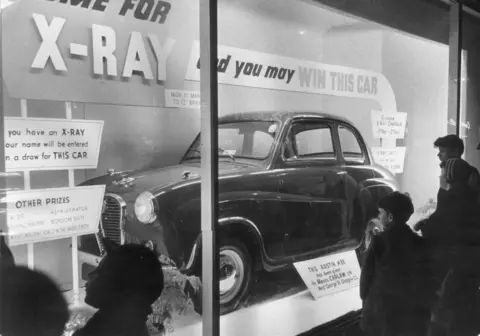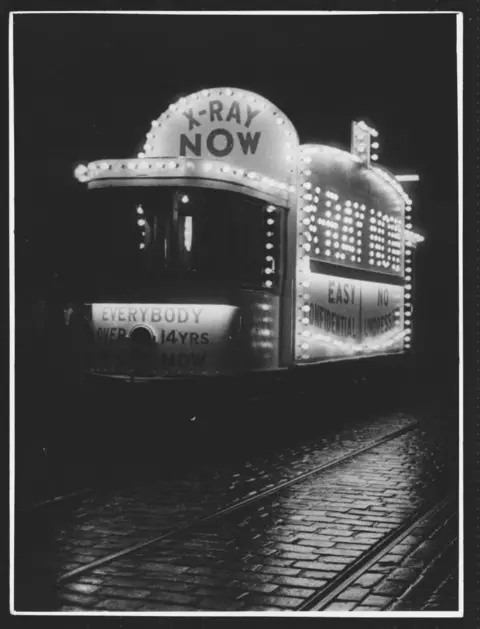How cigarettes and chocolates helped to tackle a TB epidemic
It was billed as a mass assault on a public health crisis that was gripping an impoverished post-war Glasgow.
In 1957, the city had the highest death rate from tuberculosis (TB) in Europe and health officials embarked on an ambitious "X-ray now" mass-screening campaign that saw more than 700,000 people in five weeks.
An army of 12,000 volunteers mobilised nearly three quarters of Glasgow’s population to get checked, with health officials throwing in the incentive of free prize draws for those who got X-rayed.
This included draws to win TVs, holidays and cars, but also included more unconventional prizes such as cigarettes, chickens and chocolates.
The resounding success of the 1957 programme meant 2,369 people with TB were caught and treated but a new study led by the University of Glasgow has established wider benefits.
Researchers found that because the screening programme stopped TB circulating so widely in the city, in the following five years an estimated 4,599 cases were averted, saving countless lives.
Peter MacPherson, professor of global public health at the University of Glasgow, said he hoped the lessons from 1957 can help efforts to eradicate TB today as the disease still kills more than 1.2m people a year around the world.
He said: "This mass screening had a huge impact, doubled the rate of people being detected with TB and really accelerated the reduction in cases.
"There really is nothing comparable in the world in terms of the programme's scale.
"We can learn a lot from what has been done historically - it was real civil enterprise, people’s motivations were to help their neighbours as at that time probably everyone knew someone who was affected by TB."
 Glasgow City Archives
Glasgow City ArchivesThe rapid screening programme in Glasgow involved a total of 37 mobile X-ray units and radiographers seconded from cities across the UK.
A publicity blitz about the programme saw loudspeaker vans and an illuminated tram car tour the city, aeroplane banner advertising and two specially-commissioned campaign songs broadcast at football matches.
Everyone who underwent a chest X-ray received a badge and randomly selected people spotted wearing badges received small gifts such as chocolates, chickens, and cigarettes.
There were also prize draws for participants which saw refrigerators, TVs, washing machines, holidays, furniture and a car up for grabs.
 Getty Images
Getty Images Getty Images
Getty ImagesProf MacPherson said some of the prizes, such as the cigarettes, are "things we would not recommend nowadays" but added researchers working on the study were struck by the scale of the volunteer effort to make the programme a success.
He said: "12,000 volunteers was remarkable, the people of Glasgow really came together for this going door to door and encouraging people to come forward.
"TB is quintessentially a disease of poverty
"Post-war Glasgow had some of the highest rates in Europe of TB and that was really driven by overcrowding and substandard housing, really poor nutrition after WW2 and air pollution."
He added: "Nowadays the centres of the TB infections are Africa, Asia and South America and we still have guidelines for mass screening for TB but we really don’t have a good handle on what works and this historical evidence from Glasgow can really help these places I think."
 Getty Images
Getty ImagesWhat are the symptoms of TB?
TB is bacterial infection spread through inhaling tiny droplets from the coughs or sneezes of an infected person.
While TB can be treated with antibiotics, it can be fatal if left untreated.
The World Health Organization estimates nearly 11 million people fell ill with TB worldwide last year, with more than a million of them dying.
Typical symptoms include:
- A persistent cough that lasts more than three weeks
- Weight loss
- Night sweats
- High temperature or fever
Rising cases in Scotland
Data from Public Health Scotland last month revealed that the number of TB cases in Scotland increased by just over 40% in 2023 to the highest number since 2017.
The statistics showed 283 cases of the disease were recorded last year compared with 201 in 2022.
Public Health Scotland said the incidence of the disease in people born overseas was 19.2 times higher than for people born in the UK, and there remains a "strong" link between TB cases and areas of deprivation.
Prof MacPherson said the increase showed that even a low incidence country like Scotland needs to remain vigilant and added the impact of the Covid pandemic might have disrupted diagnosis of TB cases.
He said: "The symptoms of TB are similar to Covid in some ways so with the focus so much on Covid you may not have been appropriately investigated TB cases at that that time."
